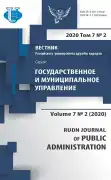US-India Nexus & Chinese Appraisal: Triangular Exertions in Central & East Asia (Brief Description)
- Autores: Nisar R.D.1
-
Afiliações:
- Central China Normal University
- Edição: Volume 7, Nº 2 (2020)
- Páginas: 141-154
- Seção: INTERNATIONAL EXPERIENCE OF PUBLIC ADMINISTRATION
- URL: https://journal-vniispk.ru/2312-8313/article/view/317668
- DOI: https://doi.org/10.22363/2312-8313-2020-7-2-141-154
- ID: 317668
Citar
Texto integral
Resumo
Palavras-chave
Sobre autores
Rana Nisar
Central China Normal University
Email: ranadanishnisar@gmail.com
PhD Scholar of the School of Politics and International Studies 152, Luoyu Road, Wuhan, Hubei, People’s Republic of China, 430079
Bibliografia
- Hosli M.O. The United Nations Security Council: History, Current Composition, and Reform Proposals. The Changing Global Order: Challenges and Prospects. Springer Nature; 2020: 299-320.
- Waltz K. Neorealism: Confusions and Criticisms. Journal of Politics and Society. 2004; 15 (1): 2-6.
- Sieff M. Shifting Superpowers: The New and Emerging Relationship between that United States, China, and India. Washington: Cato Institute; 2009.
- Naseer R., Amin M. Balance of Power: A Theoretical Explanation and Its Relevance in Contemporary Era. Berkeley Journal of Social Sciences. 2011; 1 (10): 5.
- Sharma S.D. China and India in the Age of Globalization. Cambridge: Cambridge University Press; 2009.
- Little R. The Balance of Power in International Relations: Metaphors, Myths and Models. Cambridge: Cambridge University Press; 2007.
- Craig S.L. Chinese Perceptions of Traditional and Nontraditional Security Threats. Carlisle: Strategic Studies Inst.; 2007.
- Mearsheimer J.J. The Gathering Storm: China’s Challenge to US Power in Asia. The Chinese Journal of International Politics. 2010; 3: 381-396.
- Glosserman B. A “New Type of Great Power Relations”? Hardly. Pacific Forum CSIS; 2013.
- Pillsbury M. The Hundred-Year Marathon: China’s Secret Strategy to Replace America as the Global Superpower. Henry Holt and Company; 2015.
- Gertz B. The China Threat: How the People’s Republic Targets America. Washington: Regnery Publishing; 2000.
- Garrett B. US-China Relations in the Era of Globalization and Terror: A Framework for Analysis. Journal of Contemporary China. 2006; 15 (48): 389-415.
- Tellis A.J., Mirski S. Crux of Asia: China, India, and the Emerging Global Order. Washington: Carnegie Endowment for International Peace; 2013.
- McCoy T. How Joseph Stalin Invented ‘American Exceptionalism’. The Atlantic. 2012: 3 (15). URL: https://www.theatlantic.com/politics/archive/2012/03/how-joseph-stalin-invented-american-exceptionalism/254534/. Accessed: 05.02.2020.
- Walt S.M. The Myth of American Exceptionalism. Foreign Policy. 2011. URL: https://foreignpolicy.com/2011/10/11/the-myth-of-american-exceptionalism/. Accessed: 06.02.2020.
- Shambaugh D. Tangled Titans: The United States and China. Lanham: Rowman & Littlefield Publishers; 2012.
- Zishra K. Indo-US Strategic Relations Set to Strengthen. Asia Times. URL: https://asiatimes.com/2019/03/indo-us-strategic-relations-set-to-strengthen/. Accessed: 04.02.2020.
- Ghoshal B. China’s Perception of India’s’ Look East Policy’ and Its Implications. Delhi: Institute for Defence Studies & Analyses; 2013.
- Jabeen M., Ahmed I. Indo-US Nuclear Cooperation. Journal of Contemporary Studies. 2014; 3 (1): 18.
- Guihong Z. US-India Security Relations: Implications for China. Delhi: Faultlines-New Delhi; 2003: 29-48.
- Zhang G. US-India Strategic Cooperation: Implications for China and Pakistan. International Studies. 2005; 42 (3-4): 277-293.
- Dent C.M. (Ed.). China, Japan and Regional Leadership in East Asia. Cheltenham: Edward Elgar Publishing; 2010.
- Yin L. Building a New China-US Strategic Stability. Contemporary International Relations. 2012; 22 (6): 80-97.
- Akhter S. Indo-US Strategic Partnership: Implications for China. Regional Studies. 2009; 27 (1): 3-80.
- Pantucci R. China Must Get Along with Regional Powers to Make Its New Silk Road Plan Work. South China Morning Post. 19.08.2017. URL: https://www.scmp.com/ comment/insight-opinion/article/2107122/china-must-get-along-regional-powers-make-its-new-silk-road. Accessed: 10.02.2020.
- Baiyi W. The Chinese Security Concept and Its Historical Evolution. Journal of Contemporary China. 2001; 10 (27): 275-283.
- Asher M.G., Sen R. India-East Asia Integration: A Win-Win for Asia. Economic and Political Weekly. 2005; 40 (36): 3932-3940.
- Dadwal S.R. China’s Search for Energy Security: Emerging Dilemmas. Strategic Analysis. 2007: 31 (6): 889-914.
- Zhang G. US-India Strategic Cooperation: Implications for China and Pakistan. Pakistan-China Relations in Changing Regional and Global Scenario. Karachi: Area study center; 2005.
Arquivos suplementares










